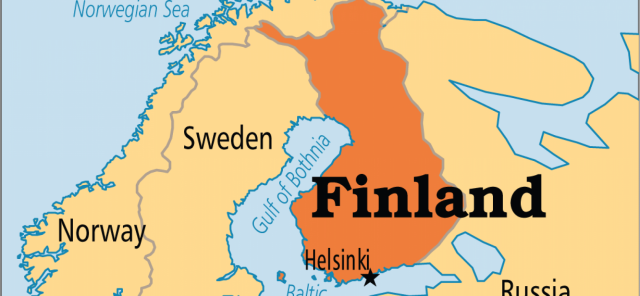Finland
Area 130,500 square mi (338,000 square km)
Population 5.464 million 2014
Capital Helsinki
Highest Point 4,426 ft (1,328 m)
Lowest Point 0 m
GDP $270.7 billion 2014
Primary Natural Resources timber, metals arable land.
AS CITIZENS OF the northernmost country in Europe, the people of Finland have long experienced the effects of their nation's absolute and relative location. Finland spans approximately 690 mi (1,104 km) from the 60th parallel in the south to the 70th parallel in the north with approximately one-third of the country falling above of the ARCTIC CIRCLE. While the climate of Finland is moderated by the effects of the Baltic Sea, it is nonetheless greatly determined by its high latitude. The mean annual temperature of its capital, Helsinki, is only 41 degrees F (5.3 degrees C) with an average July temperature of 62 degrees F (17 degrees C) and February temperature of 22 degrees F (-5.7 degrees C).

PHYSICAL GEOGRAPHY
The physical geography of Finland has also been greatly shaped by its absolute location as a result of continental glaciation that once covered large portions of northern Europe. As the ice advanced and retreated across the landscape, it carved the southeastern portion of Finland into a patchwork of shallow lakes, giving Finland's its nickname, Land of a Million Lakes. The movement of ice sheets was never constant, and in their retreat they remained stationary three times, depositing rock and sediment debris to form moraines and drumlins. Stream flow beneath the glaciers deposited additional material, thereby forming ESKERs that stretch from east to west across the country and are called the Salpauselka ranges. With the retreat of the ice approximately 12,000 years ago, the land itself reemerged from the sea, freed from the immense weight of the glaciers. This process continues today, with the land area of Finland increasing by approximately 2.7 square mi (7 square km) annually.
The postglacial landscape combined with the high latitude provide the basis for a natural environment predominated by boreal forests in the south and lowlying scrub vegetation in the northern reaches of Lapland. As a natural resource, the forests of Finland play a significant role in the economy of the nation with the development of lumber and paper industries. With significant governmental intervention in the 20th century, the Finnish wood industries have worked to increase timber harvests while conserving forested land in the interest of recreation and other nonindustrial uses.
The forests have also been long associated with the development of Finnish culture. Although Finnish society first developed with agriculture, the forests continued to represent a store of wealth for the inhabitants with their abundant flora and fauna. The natural resources of Finland also caught the attention of growing European empires. With the expansions of the Vikings eastward toward RUSSIA, the people of Finland were eventually incorporated into the Kingdom of SWEDEN and converted from their preexisting pagan beliefs to Roman Catholicism. With the development of the Great Schism and eventual adoption of Orthodox Christianity in Russia, Finland became a religious and imperial battleground between East and West. For approximately 800 years, the majority of contemporary Finland remained within the domain of the Kingdom of Sweden, even converting to Christian Protestantism with the arrival of the Reformation. But after multiple wars and several tenuous periods of peace throughout those centuries, control of Finland was transferred to the Russian empire in 1809.
As an autonomous grand duchy under the control of the Russian tzar, Finnish governmental organization remained relatively unchanged and experienced, at least for a brief span of time, an unprecedented period of peace free from the wars that had plagued its people for centuries.
With the demise of the Russian Empire in 1917, Finland sought its own independence and the Republic of Finland was declared. The transition to independence was not without conflict, however, and the people of Finland were embroiled within a civil war between the Reds and the Whites, both of which sought control of the new nation. Less than 20 years later, Finland was once again engaged in conflict, this time caught in the power struggle between GERMANY and the Soviet Union in World War II. The conclusion of the war ultimately resulted in the loss of eastern Finnish territory in the region of Karelia to the Soviet Union.
WELFARE STATE
Despite the devastation of World War II, throughout the latter half of the 20th century, the democratic government of Finland has invested heavily in both the economy and its citizens, evolving into a Scandinavian welfare state that operates on the premise that the role of government is to care for its citizens from “cradle to grave.”
While Finland experienced some economic struggles in more recent decades, its economy has been revived by the growth of high-tech industries within its borders, including companies such as mobile telephone communication giant Nokia. The people of Finland have embraced technology as a globalizing force that allows a country long isolated linguistically and physically to become more integrated into the world economy.
These events, combined with membership in the EUROPEAN UNION in 1995 and the adoption of the euro as its currency unit in 2002, served to further increase the impact Finland and its people will have upon the rest of the world.